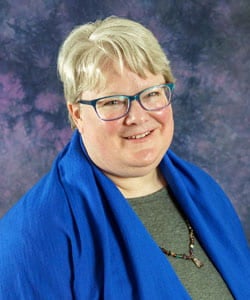How Stacie Salsbury, M.S.N., Ph.D., R.N., advances chiropractic care in multidisciplinary settings through research.
Stacie Salsbury, M.S.N., Ph.D., R.N., was fascinated with Palmer College of Chiropractic as a child. Today, she’s an associate professor at the Palmer Center for Chiropractic Research.
 “My grandparents lived near downtown Davenport, and we would always drive through campus on our way home. Each time, I stayed awake just long enough to see the Little Bit O’Heaven garden,” says Dr. Salsbury.
“My grandparents lived near downtown Davenport, and we would always drive through campus on our way home. Each time, I stayed awake just long enough to see the Little Bit O’Heaven garden,” says Dr. Salsbury.
She began her career as a nurse, eventually earning her doctor of philosophy in gerontological nursing.
“As a nurse I was always drawn to chronic-care settings. I worked in hemodialysis, long-term care and in an osteopathic hospital. I’ve seen that there are many ways to take care of people’s health.”
It’s with that perspective that she’s conducted research at the Palmer Center for Chiropractic Research for the past 11 years.
“There’s a lot of room on a health care team to help people live their best lives possible. My area of focus is demonstrating how the addition of chiropractic care within a multidisciplinary environment benefits patients.”
Dr. Salsbury’s favorite study to date is one in which chiropractic care was integrated into the multidisciplinary team caring for patients who had suffered spinal cord injury, brain injury or stroke at Crotched Mountain Specialty Hospital over the course of 15 months. In addition to the research impact of this study, it’s unique that it was funded by Palmer alumnus William Kiernan, D.C. (Main, ’72), and his wife, Mary.
“When this study began, there was a multidisciplinary team in place but no chiropractors. We really saw an evolution within the care team over time; they became more open to the idea of having a chiropractor on the team. From the patients, we saw that the chiropractor offered a safe space where they could take a breath and resettle.”
The study team on this project also included three doctors of chiropractic who were M.S. students working to build experience in chiropractic research.
“During qualitative research, such as the study at Crotched Mountain, you spend time with people’s thoughts and words — interviewing people and analyzing the responses, rereading the material, studying where it fits into the current literature and asking yourself if there are new thoughts or ideas that need to be explored. This is the type of research mindset that students learn when they’re involved in studies at Palmer.”
Currently, Dr. Salsbury is leading the Active Aging for Spine Health Study to identify the best ways chiropractors can deliver patient education for middle-aged and older individuals.
“I got interested in this topic when I started experiencing pain after doing everyday activities like gardening, and my doctor told me that maybe I needed to stop doing these things. That’s when I realized that there are a lot of people out there who need education about how chiropractic care can allow people to continue doing things they love. It’s just a matter of identifying the best ways to deliver that patient education.”
When asked about the impact of her research, Dr. Salsbury reflects, “When I was a practicing nurse, I got to see how I helped individuals every day. When you’re a chiropractor, you see the impact of your work every day. Yet when you’re a researcher, you have to know that while your work has the potential to reach many people over a long period of time, you may never see that directly. We’re still creating new knowledge from studies we began 11 years ago when I started at Palmer — and that’s pretty exciting.”
References:
Want to know more about the research referenced in this story? View the full studies online:
Salsbury SA, Vining RD, Gosselin D, Goertz CM. (2018). Be good, communicate, and collaborate: a qualitative analysis of stakeholder perspectives on adding a chiropractor to the multidisciplinary rehabilitation team. Chiropractic & Manual Therapies, 26:29.
https://chiromt.biomedcentral.com/articles/10.1186/s12998-018-0200-4
Maiers M, Salsbury SA. (Published ahead of print). “Like peanut butter and jelly”: a qualitative study of chiropractic care and home exercise among older adults with spine disability. Arthritis Care & Research. https://onlinelibrary.wiley.com/doi/10.1002/acr.24636
READ MORE from Palmer Proud Magazine

